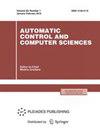基于椭圆曲线等同源的多重签名协议的掩蔽方法
IF 0.5
Q4 AUTOMATION & CONTROL SYSTEMS
引用次数: 0
摘要
在美国国家标准与技术研究院(NIST)选择用于标准化的后量子算法中,主要的数学装置是代数格机制,而哈希函数装置是另一种选择。与椭圆曲线的同生曲线不同,这些机制使用更大的公钥和签名。通过一个基于椭圆曲线等基因的多重签名协议的例子,我们将展示如何使用掩蔽方法来防止对给定设备的主攻击,同时获得较小的签名大小。本文章由计算机程序翻译,如有差异,请以英文原文为准。

On the Method of Masking in the Multiple Signature Protocol Based on Isogenies of Elliptic Curves
Among the post-quantum algorithms selected by the National Institute of Standards and Technology (NIST) for standardization, the main mathematical apparatus is the mechanism of algebraic lattices, while the apparatus of hash functions is an alternative. Unlike isogenies of elliptic curves, these mechanisms use larger sizes of both public keys and signatures. Using the example of a multiple signature protocol based on isogenies of elliptic curves, we will show how, using the masking method, we can protect against the main attack on the given device, while obtaining a smaller signature size.
求助全文
通过发布文献求助,成功后即可免费获取论文全文。
去求助
来源期刊

AUTOMATIC CONTROL AND COMPUTER SCIENCES
AUTOMATION & CONTROL SYSTEMS-
CiteScore
1.70
自引率
22.20%
发文量
47
期刊介绍:
Automatic Control and Computer Sciences is a peer reviewed journal that publishes articles on• Control systems, cyber-physical system, real-time systems, robotics, smart sensors, embedded intelligence • Network information technologies, information security, statistical methods of data processing, distributed artificial intelligence, complex systems modeling, knowledge representation, processing and management • Signal and image processing, machine learning, machine perception, computer vision
 求助内容:
求助内容: 应助结果提醒方式:
应助结果提醒方式:


